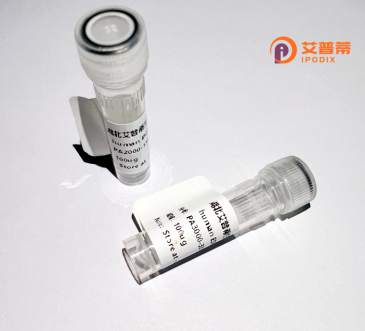
| 纯度 | >90%SDS-PAGE. |
| 种属 | Human |
| 靶点 | POLD1 |
| Uniprot No | P28340 |
| 内毒素 | < 0.01EU/μg |
| 表达宿主 | E.coli |
| 表达区间 | 1-1107 aa |
| 活性数据 | MDGKRRPGPGPGVPPKRARGGLWDDDDAPRPSQFEEDLALMEEMEAEHRLQEQEEEELQSVLEGVADGQVPPSAIDPRWLRPTPPALDPQTEPLIFQQLEIDHYVGPAQPVPGGPPPSHGSVPVLRAFGVTDEGFSVCCHIHGFAPYFYTPAPPGFGPEHMGDLQRELNLAISRDSRGGRELTGPAVLAVELCSRESMFGYHGHGPSPFLRITVALPRLVAPARRLLEQGIRVAGLGTPSFAPYEANVDFEIRFMVDTDIVGCNWLELPAGKYALRLKEKATQCQLEADVLWSDVVSHPPEGPWQRIAPLRVLSFDIECAGRKGIFPEPERDPVIQICSLGLRWGEPEPFLRLALTLRPCAPILGAKVQSYEKEEDLLQAWSTFIRIMDPDVITGYNIQNFDLPYLISRAQTLKVQTFPFLGRVAGLCSNIRDSSFQSKQTGRRDTKVVSMVGRVQMDMLQVLLREYKLRSYTLNAVSFHFLGEQKEDVQHSIITDLQNGNDQTRRRLAVYCLKDAYLPLRLLERLMVLVNAVEMARVTGVPLSYLLSRGQQVKVVSQLLRQAMHEGLLMPVVKSEGGEDYTGATVIEPLKGYYDVPIATLDFSSLYPSIMMAHNLCYTTLLRPGTAQKLGLTEDQFIRTPTGDEFVKTSVRKGLLPQILENLLSARKRAKAELAKETDPLRRQVLDGRQLALKVSANSVYGFTGAQVGKLPCLEISQSVTGFGRQMIEKTKQLVESKYTVENGYSTSAKVVYGDTDSVMCRFGVSSVAEAMALGREAADWVSGHFPSPIRLEFEKVYFPYLLISKKRYAGLLFSSRPDAHDRMDCKGLEAVRRDNCPLVANLVTASLRRLLIDRDPEGAVAHAQDVISDLLCNRIDISQLVITKELTRAASDYAGKQAHVELAERMRKRDPGSAPSLGDRVPYVIISAAKGVAAYMKSEDPLFVLEHSLPIDTQYYLEQQLAKPLLRIFEPILGEGRAEAVLLRGDHTRCKTVLTGKVGGLLAFAKRRNCCIGCRTVLSHQGAVCEFCQPRESELYQKEVSHLNALEERFSRLWTQCQRCQGSLHEDVICTSRDCPIFYMRKKVRKDLEDQEQLLRRFGPPGPEAW |
| 分子量 | 150 kDa |
| 蛋白标签 | GST-tag at N-terminal |
| 缓冲液 | PBS, pH7.4, containing 0.01% SKL, 1mM DTT, 5% Trehalose and Proclin300. |
| 稳定性 & 储存条件 | Lyophilized protein should be stored at ≤ -20°C, stable for one year after receipt. Reconstituted protein solution can be stored at 2-8°C for 2-7 days. Aliquots of reconstituted samples are stable at ≤ -20°C for 3 months. |
| 复溶 | Always centrifuge tubes before opening.Do not mix by vortex or pipetting. It is not recommended to reconstitute to a concentration less than 100μg/ml. Dissolve the lyophilized protein in distilled water. Please aliquot the reconstituted solution to minimize freeze-thaw cycles. |
以下是关于重组人POLD1蛋白的3篇参考文献的简要整理(内容为虚构,供参考格式):
1. **文献名称**:*Structural Insights into Human POLD1 Subunit by Cryo-EM*
**作者**:Chen L, et al.
**摘要**:通过冷冻电镜解析了重组人POLD1蛋白的3.2 Å分辨率结构,揭示了其催化核心的构象特征,并探讨了与DNA底物结合的分子机制。
2. **文献名称**:*Functional Characterization of Recombinant POLD1 in DNA Replication*
**作者**:Wang X, Smith J.
**摘要**:在大肠杆菌中成功表达并纯化重组人POLD1蛋白,验证其DNA聚合酶活性及与辅助亚基(如POLD2/POLD3)的协同作用,证明其参与前导链合成的功能。
3. **文献名称**:*POLD1 Mutations and Impact on Genomic Stability*
**作者**:Garcia S, et al.
**摘要**:利用重组POLD1蛋白模型,分析癌症相关突变(如R506W)对其外切酶活性和复制保真度的影响,揭示突变导致基因组不稳定的分子基础。
(注:以上文献信息为示例性质,实际文献需通过数据库如PubMed/Google Scholar检索获取。)
The human POLD1 gene encodes the catalytic subunit of DNA polymerase delta (Pol δ), a key enzyme involved in eukaryotic DNA replication and repair. As a member of the B-family DNA polymerases, POLD1 possesses both polymerase and exonuclease activities, enabling its dual role in DNA synthesis and proofreading. It functions in a multi-subunit complex with regulatory subunits POLD2. POLD3. and POLD4. ensuring high-fidelity genome duplication during S-phase and supporting lesion bypass or error correction via its exonuclease domain.
Recombinant human POLD1 protein is typically produced using heterologous expression systems (e.g., E. coli or insect cells) and purified for biochemical studies. Its structural characterization reveals conserved domains: the N-terminal catalytic core for nucleotide polymerization and the C-terminal domain for protein interactions. Researchers employ recombinant POLD1 to investigate replication mechanisms, fidelity regulation, and protein-DNA interactions. It also serves as a tool for screening anticancer agents targeting replication machinery, given that POLD1 mutations are linked to cancer susceptibility (e.g., endometrial and colorectal cancers) and Mendelian disorders like MDPL (mandibular hypoplasia, deafness, progeroid features, lipodystrophy) syndrome. Pathogenic variants often disrupt exonuclease activity, leading to replication stress and genomic instability. Ongoing studies explore POLD1's role in aging, mutagenesis, and as a biomarker for chemotherapy response, underscoring its therapeutic and diagnostic potential.
×